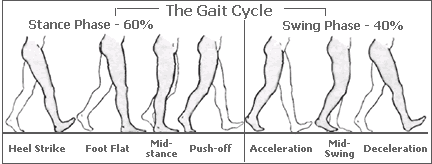In the basic gait cycle the movements are divided into the times when the foot is on the ground (the stance phase which takes up 60% of the full gait cycle and 62% when running ) and when the foot is off the ground (the swing phase which takes up the remaining 40% of one full gait cycle and 38% while running).
 Contact: The beginning of the gait cycle is marked by the heel contacting the ground. This is called heel strike.
Contact: The beginning of the gait cycle is marked by the heel contacting the ground. This is called heel strike. Forefoot contact: The forefoot contacts the ground, stabilizing the foot and the body.
Midstance: When the weight of the body is directly over the foot. The opposite foot is swinging from the rear of the body towards the front of the body.
Heel off: When the heel starts to lift from the ground, the weight shifts to the front of the foot. The opposite foot has made contact with the ground.
Push off: Also called toe off and propulsion, this phase is the terminal stance phase of the gait cycle, which means that the foot is pushing off the ground and will be entering the swing phase (swinging from the rear of the body to the front of the body).
During the normal gait cycle (normal walking) the feet supinate and pronate. It's important to understand that pronation is a normal motion when walking.
If something is wrong with the gait/ run cycle
Websites:
http://www.aaronswansonpt.com/wp-content/uploads/2011/06/thegaitcycle.gif
http://www.sportspodiatry.co.uk/biomechanics.htm
http://www.orthoticshop.com/orthotic-adjustments-foot-biomechanics.html
http://drgreenapple.com/custom_content/c_133946_videos.html



No comments:
Post a Comment